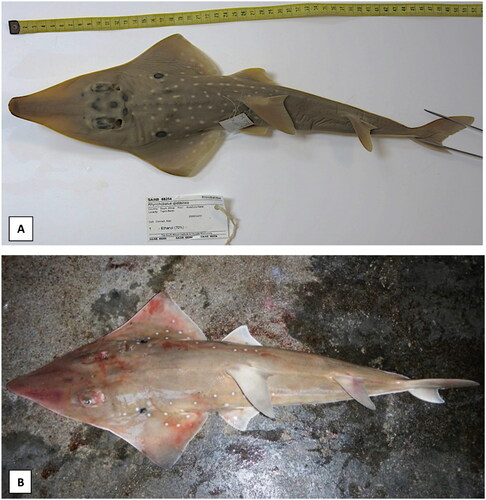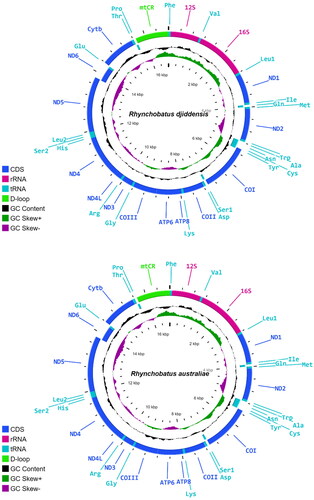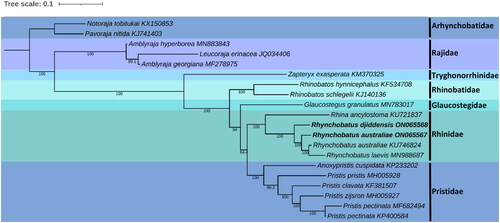Figures & data
Figure 1. Species reference images of (A) Rhynchobatus djiddensis (Photo by the South African Institute for Aquatic Biodiversity), the whitespotted wedgefish, with prominent black markings between eyes, large number of white spots and black pectoral marking surrounded by four or more white spots and (B) Rhynchobatus australiae (Photo by John Nevill), the bottlenose wedgefish, with bottle-shaped snout slightly constricted near tip, three white spots aligned over the pectoral marking (usually two spots below), a short line of well-demarcated white spots on the mid dorsal surface and no spots on the tail (TL = 137 cm).

Table 1. Whole mitogenomes from the order Rhinopristiformes used to infer the phylogenetic placement of R. djiddensis (ON065568) and R. australiae (ON065567).
Figure 2. Gene maps of the Rhynchobatus djiddensis (ON065568) and Rhynchobatus australiae (ON065567) mitogenomes. The outermost circle genes are transcribed clockwise and the rest counter clockwise.

Figure 3. Maximum-likelihood phylogeny of five families from the order Rhinopristiformes based on the concatenated dataset of 13 protein-coding genes, with members of the families Rajidae and Arhynchobatidae included as outgroups. Numbers at nodes indicate bootstrap values. GenBank accession numbers are given adjacent to the species name, scale bar indicates groupings of species into families and the taxa in bold are the mitogenomes from this study.

Table 2. Single nucleotide polymorphisms (SNPs) found in 16 regions of the mitogenomes from this study; Rhynchobatus djiddensis (ON065568) and Rhynchobatus australiae (ON065567), and the online-available R. australiae sequence (KU746924).
Supplemental Material
Download PDF (366.2 KB)Supplemental Material
Download PDF (111.7 KB)Supplemental Material
Download PDF (148.8 KB)Data availability statement
The genome sequence data that support the findings of this study are openly available in GenBank of NCBI (https://www.ncbi.nlm.nih.gov/) under the accession numbers ON065567–ON065568. The associated BioProject, SRA, and Bio-Sample numbers are PRJNA886704, SRX17782697–SRX17782698, and SAMN31139799–SAMN31139800, respectively.
